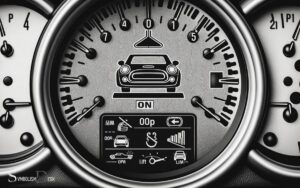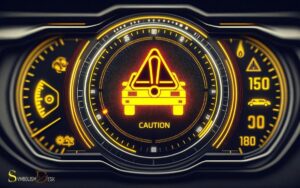Low Water Symbol in Car: Cooling System!
The low water symbol in a car typically indicates that the coolant level in the vehicle’s radiator and cooling system is insufficient.
This warning sign alerts the driver that they need to check and refill the coolant to prevent the engine from overheating, which can lead to serious mechanical damage.
The cooling system in a car is essential for maintaining the engine’s temperature within its optimal range. The low water symbol, often represented by a thermometer submerged in liquid or a similar icon, is an important indicator on the car’s dashboard.
When this symbol illuminates, it means the engine’s coolant level is below the recommended threshold. Coolant, a mixture of water and antifreeze, absorbs heat from the engine and dissipates it through the radiator.
A low coolant level can cause the engine to run hotter than normal, potentially leading to overheating.
If the symbol appears, it’s crucial to:
For example, if you’re driving and notice the low water symbol on your dashboard, you should immediately take steps to address the issue to prevent engine damage.
Ignoring the low water symbol in your car can lead to costly repairs, so it’s essential to act promptly and maintain proper coolant levels for your vehicle’s longevity.
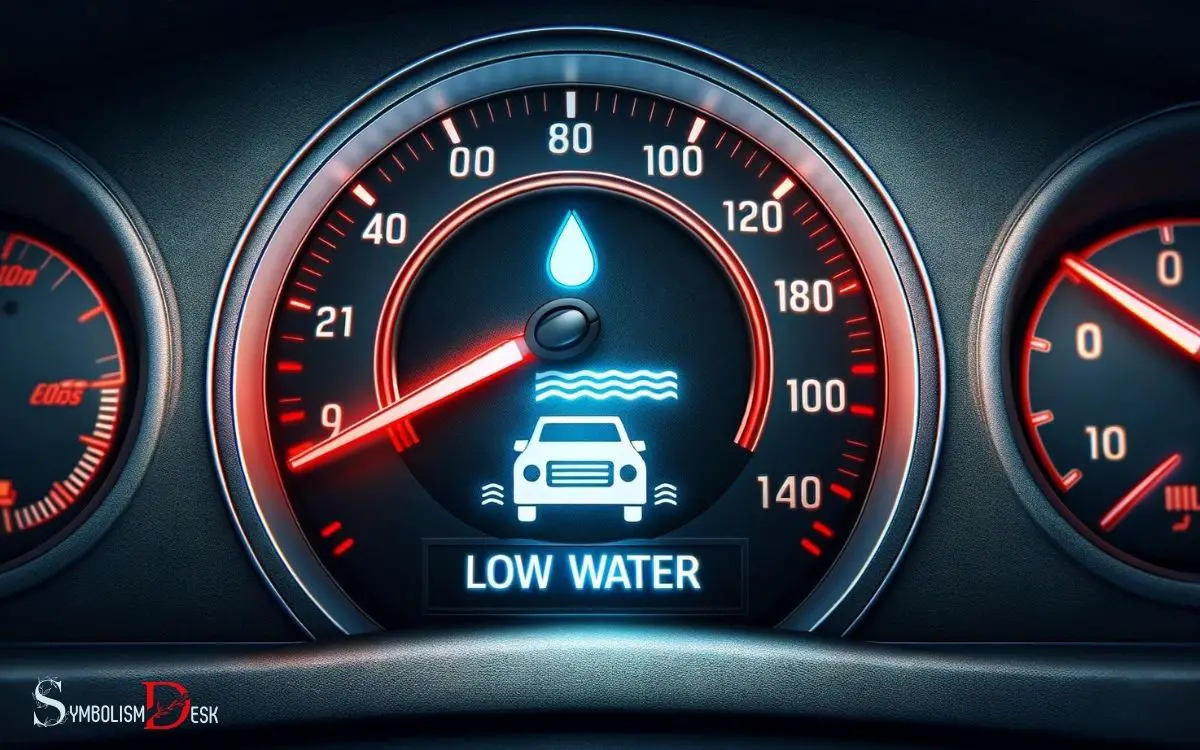
Key Takeaway
Understanding the Low Water Symbol
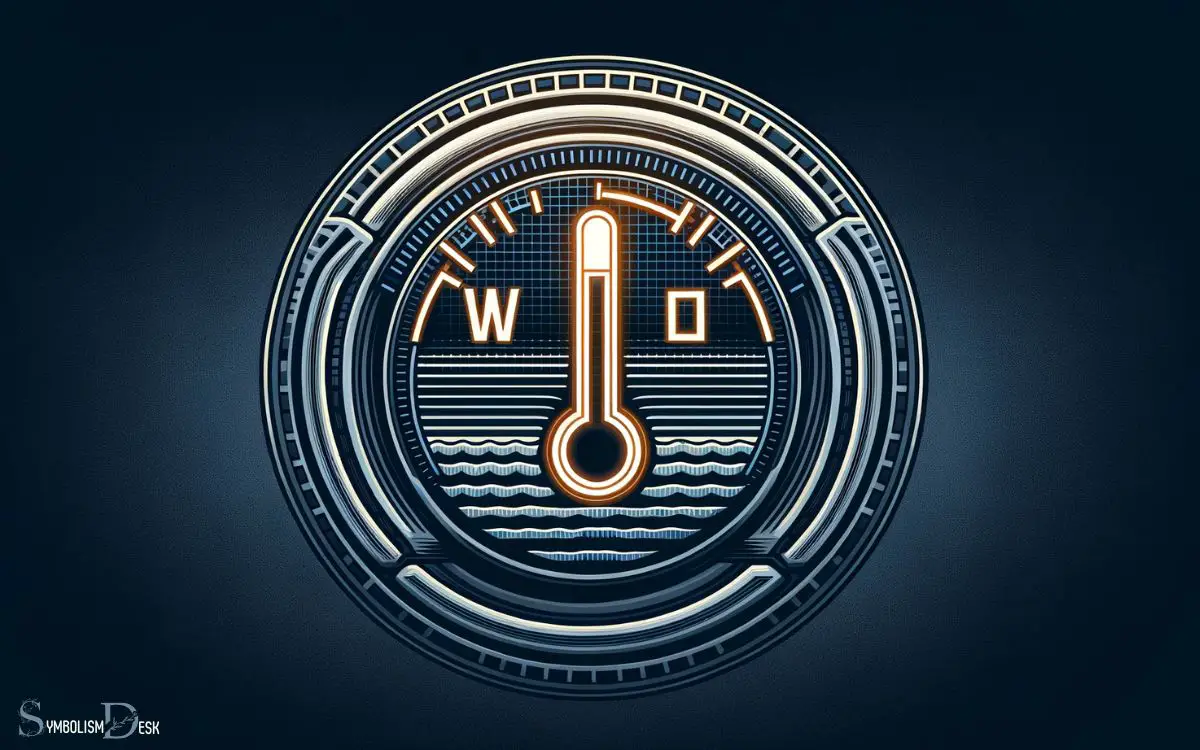
As a driver, it is essential to understand the low water symbol in your car, as it indicates a potential issue with the vehicle’s cooling system.
The low water symbol typically resembles a thermometer or a water droplet, and when it illuminates on the dashboard, it signifies that the engine is running hotter than normal due to low coolant levels.
This could be caused by a leak in the cooling system, a malfunctioning radiator cap, or a problem with the water pump. Ignoring this warning could lead to overheating and serious damage to the engine.
Therefore, it is crucial to promptly address the low water symbol by checking the coolant levels, looking for any visible leaks, and consulting a professional if needed.
Understanding and responding to this symbol can prevent costly repairs and ensure the vehicle’s optimal performance.
Importance of Addressing the Warning
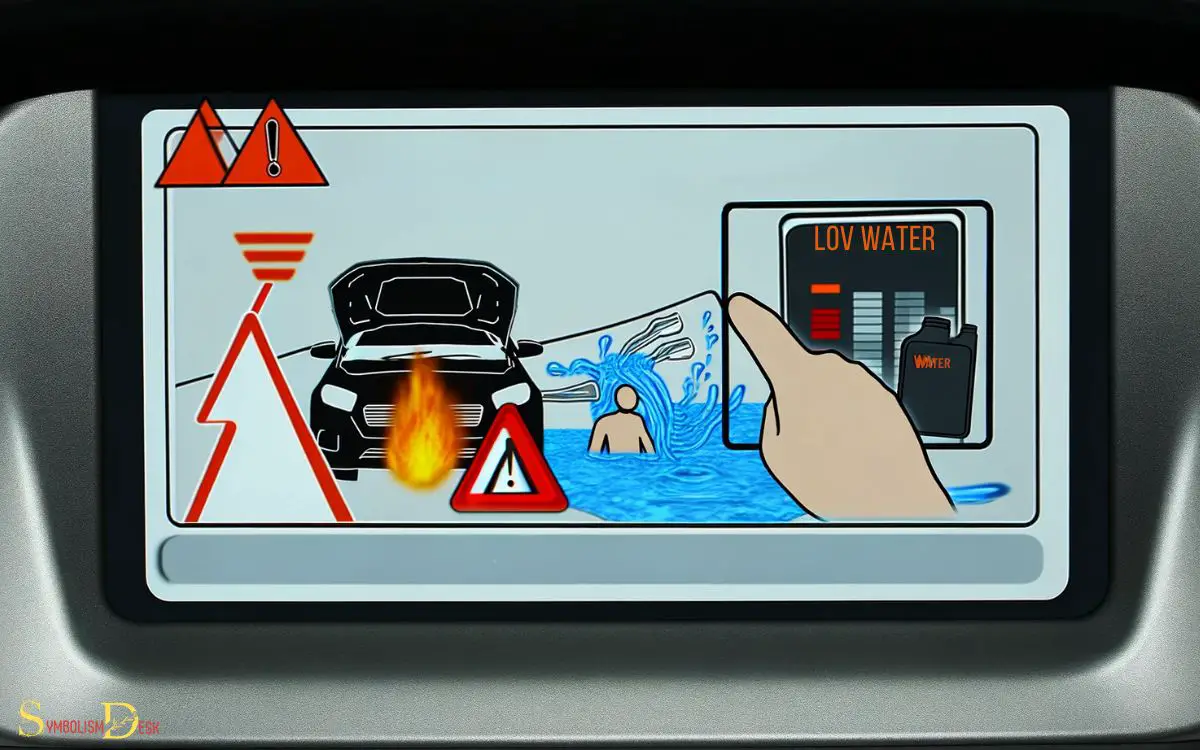
Promptly addressing the warning is crucial for maintaining the vehicle’s performance and preventing potential damage. Ignoring the low water symbol in a car can lead to overheating, engine damage, and ultimately costly repairs. Additionally, modern vehicles are equipped with various alerts to ensure optimal functioning, such as the smart key battery low warning. Addressing this warning is just as important, as a depleted key battery could leave you unable to start or unlock your car. Regularly monitoring and responding to these indicators helps prevent inconvenience and ensures the longevity of your vehicle.
Coolant plays a vital role in regulating the engine’s temperature, and low levels can result in overheating, which may lead to severe engine damage.
Additionally, coolant also has anti-corrosive properties that help protect the engine and its components. Neglecting the warning can compromise these critical functions and jeopardize the overall performance and longevity of the vehicle.
Regularly checking and addressing the low water symbol ensures that the engine operates within its optimal temperature range and maintains its efficiency.
Thus, attending to this warning promptly is essential for preserving the vehicle’s reliability and preventing potential mechanical issues.
Potential Risks of Low Coolant Level
Maintaining the proper coolant level is crucial to preventing engine overheating, which can lead to severe damage and potential breakdowns.
Low coolant levels can also negatively impact engine performance, causing inefficiencies and potential long-term issues.
Additionally, inadequate coolant levels can result in damage to critical engine components, leading to costly repairs and decreased vehicle reliability.
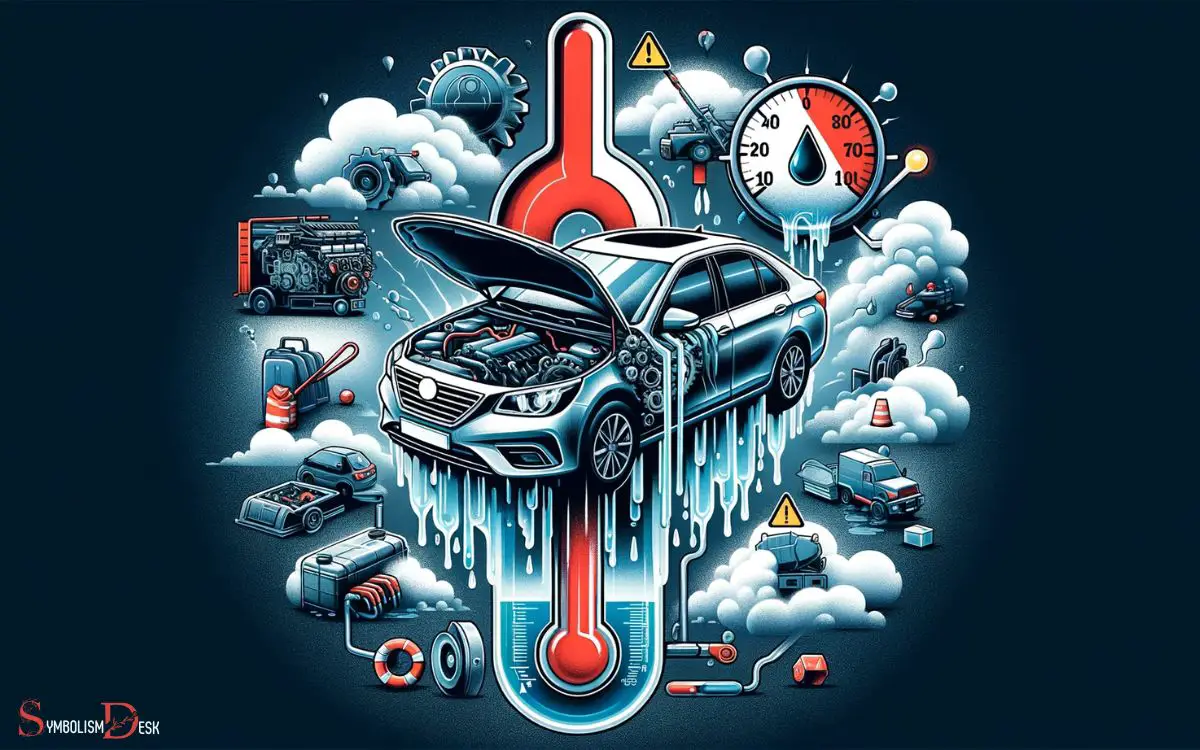
Engine Overheating Dangers
The low coolant level in a car’s engine can pose serious risks of overheating. When the engine overheats, it can lead to severe damage and potentially dangerous situations.
The following are potential risks associated with engine overheating:
- Increased wear and tear on engine components
- Warped cylinder head or blown head gasket
- Engine knocking or pinging
- Complete engine failure
- Risk of fire due to extreme temperatures
It is vital to monitor the coolant level regularly and address any leaks or low levels promptly to prevent these dangers.
Additionally, proper maintenance and regular inspections are essential to ensure the cooling system functions effectively and to mitigate the risks of engine overheating.
Impact on Engine Performance
An engine’s performance can be significantly compromised due to low coolant levels, leading to potential risks and damage. Coolant, also known as antifreeze, plays a crucial role in maintaining the engine’s temperature within the optimal range.
When the coolant level is low, the engine is at a higher risk of overheating, which can result in severe damage to the engine components.
Additionally, low coolant levels can lead to ineffective heat transfer, causing the engine to run hotter than intended.
This can negatively impact various engine functions, such as combustion efficiency and overall performance.
Furthermore, inadequate coolant circulation can lead to corrosion and rust within the cooling system, further deteriorating engine performance.
Therefore, maintaining the recommended coolant level is essential to prevent potential risks and ensure optimal engine performance.
Potential Damage to Components
Low coolant levels in a car can pose significant risks and potential damage to engine components.
The following potential risks of low coolant level should be carefully considered:
- Overheating: Insufficient coolant can lead to overheating, causing serious damage to the engine.
- Corrosion: Low coolant levels can lead to corrosion of the internal components of the cooling system, such as the radiator and water pump.
- Increased friction: Without adequate coolant, there is increased friction and heat generation within the engine, leading to accelerated wear and tear.
- Blown head gasket: The lack of coolant can cause the engine to overheat, potentially resulting in a blown head gasket.
- Engine seizure: In extreme cases, low coolant levels can cause the engine to seize, leading to catastrophic damage.
Ensuring proper coolant levels and identifying leaks is crucial to prevent these potential issues.
Checking Coolant Levels and Identifying Leaks
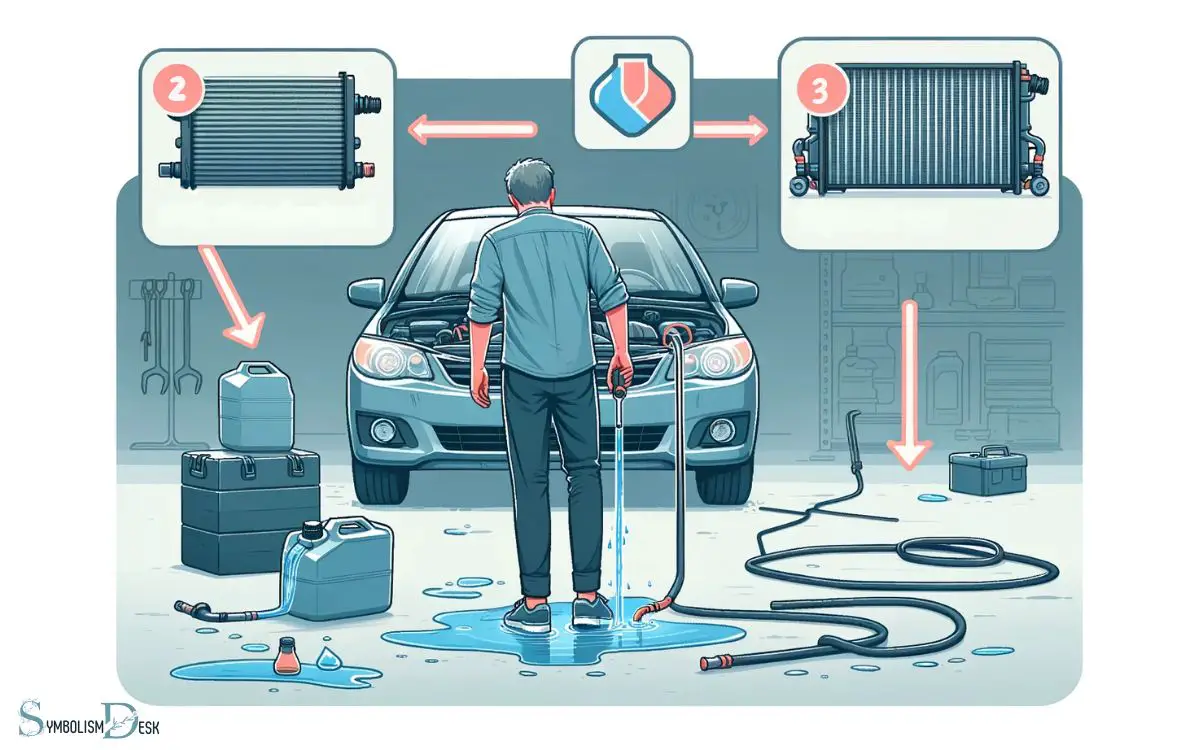
Coolant levels should be regularly checked to identify any potential leaks in the car’s cooling system. Low coolant levels can lead to overheating and potential damage to the engine. To check the coolant levels, ensure the engine is cool, and then locate the coolant reservoir.
The coolant level should be between the minimum and maximum marks. If it’s low, top it up with a mixture of coolant and water as specified in the car’s manual.
Additionally, inspect the reservoir and the surrounding areas for any signs of leaks, such as puddles or stains. Leaks can occur from hoses, the radiator, or the water pump.
Identifying and addressing leaks promptly is crucial to maintaining the proper functioning of the cooling system and preventing costly damage to the engine.
Steps to Top up Coolant in Your Car
To top up the coolant in your car, start by checking the coolant level when the engine is cool. Locate the coolant reservoir, usually a translucent plastic tank with a “full” line marked on the side.
If the level is low, add the appropriate coolant mixture to bring it up to the “full” line, ensuring it is the correct type for your vehicle.
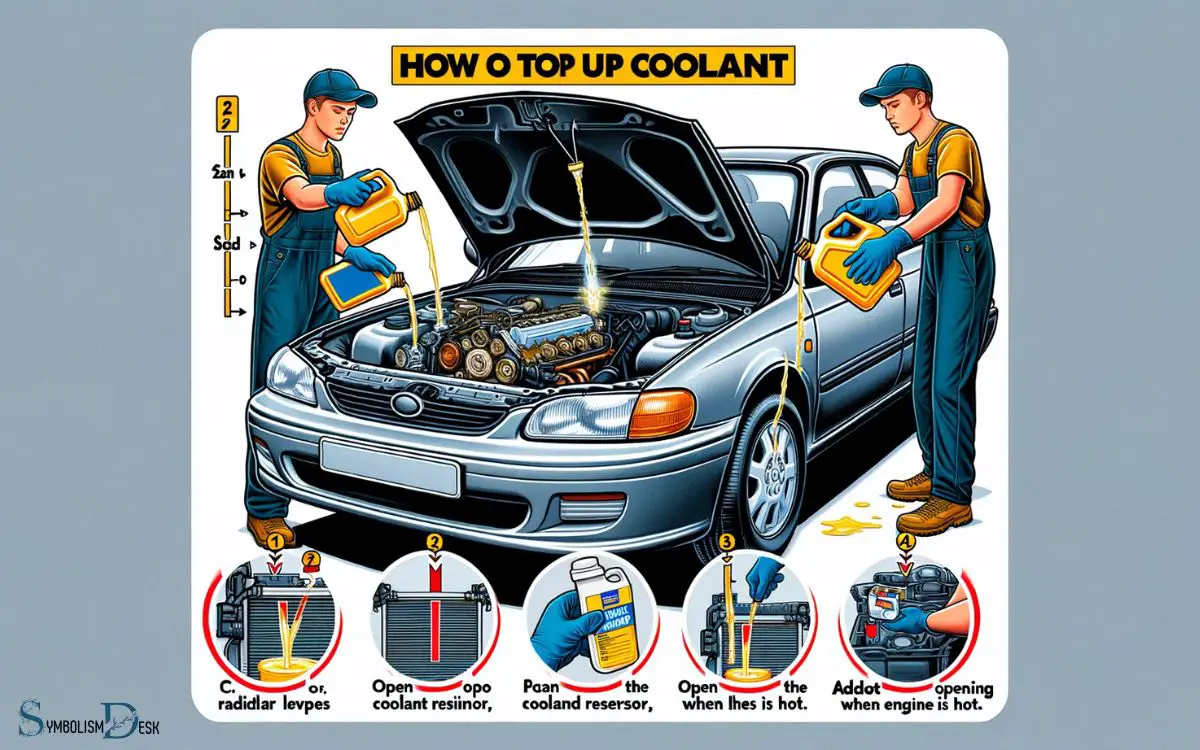
Check Coolant Level
The process of checking the coolant level in your car involves locating the coolant reservoir.
To top up the coolant, follow these steps:
- Park the car on a level surface and allow the engine to cool down.
- Locate the coolant reservoir, which is often a translucent plastic tank with a “coolant” label.
- Check the coolant level against the markings on the reservoir. It should be between the minimum and maximum markers.
- If the level is low, carefully unscrew the reservoir cap when the engine is cool, and add a mixture of coolant and water to the reservoir.
- Securely tighten the cap and run the engine for a few minutes to ensure proper circulation of the coolant.
Regularly checking and topping up the coolant level helps maintain the car’s cooling system and prevents overheating.
Locate Coolant Reservoir
When topping up the coolant in your car, begin by locating the coolant reservoir on a level surface. The coolant reservoir is typically a translucent plastic tank with a cap labeled “coolant” or “antifreeze.”
It is often located near the radiator and has markings indicating the minimum and maximum levels for the coolant.
Once you have located the reservoir, ensure that the engine is cool before opening the cap, as pressurized hot coolant can cause burns.
If the coolant level is below the minimum mark, carefully add a mixture of coolant and water according to your vehicle’s specifications.
Remember to tighten the cap securely after topping up the coolant. Regularly checking and topping up the coolant will help maintain your car’s optimal performance and prevent overheating.
Add Coolant as Needed
Before adding coolant as needed, it is important to verify the appropriate coolant type and mixture ratio according to your car manufacturer’s specifications.
- Park the car on a level surface and allow the engine to cool down.
- Locate the coolant reservoir and check the current coolant level.
- If the coolant level is low, open the reservoir cap after ensuring the engine is cool.
- Add a mixture of coolant and water as per the manufacturer’s recommendations.
- Securely replace the reservoir cap and run the engine to check for any leaks.
Professional Assistance for Coolant System
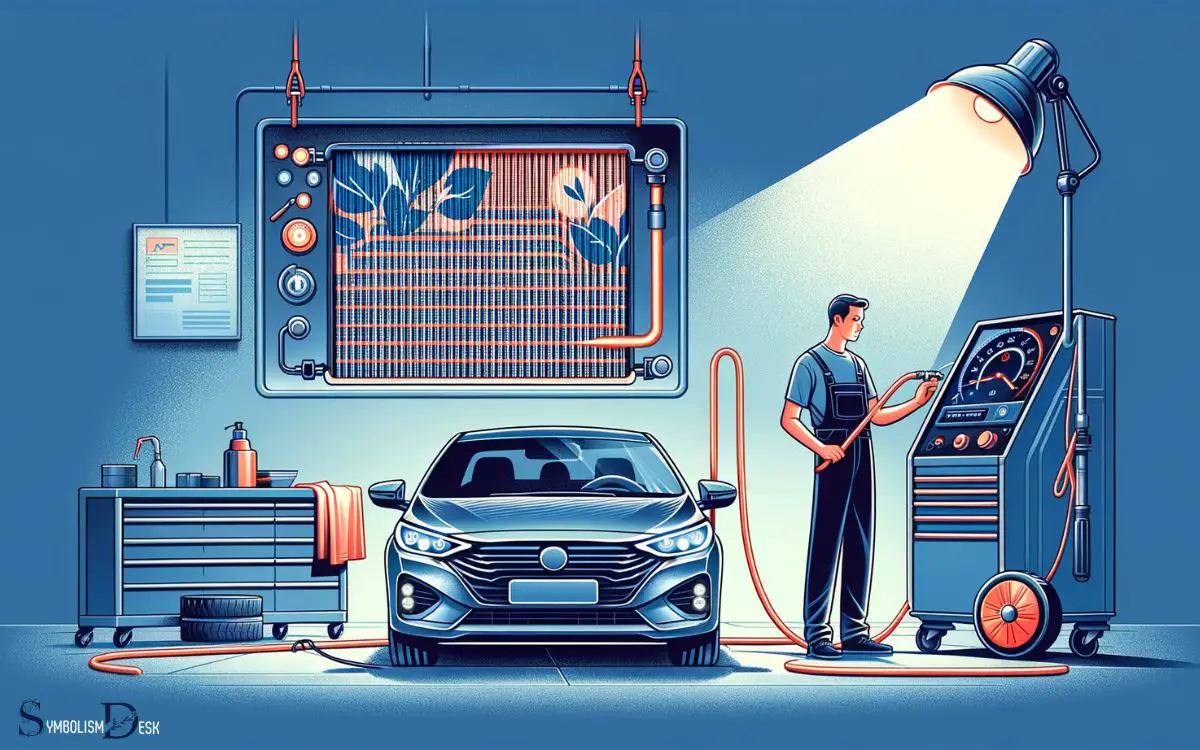
Seek professional assistance for diagnosing and addressing issues with your car’s coolant system. A qualified mechanic can conduct a thorough inspection to identify any leaks, blockages, or malfunctions in the system.
They have the expertise to assess the condition of the radiator, hoses, water pump, and thermostat.
Professional assistance ensures that the coolant is at the correct concentration and that there are no underlying problems causing the low water symbol to illuminate.
Additionally, a mechanic can perform a pressure test to check for any internal or external leaks that may be contributing to the low coolant level.
Trusting a skilled professional to address coolant system issues can prevent costly damage to your vehicle and ensure optimal performance and safety on the road.
Preventive Maintenance for Coolant Levels
Regular monitoring of coolant levels is essential for preventive maintenance of your vehicle’s cooling system. Proper coolant levels are crucial for preventing engine overheating and maintaining optimal performance.
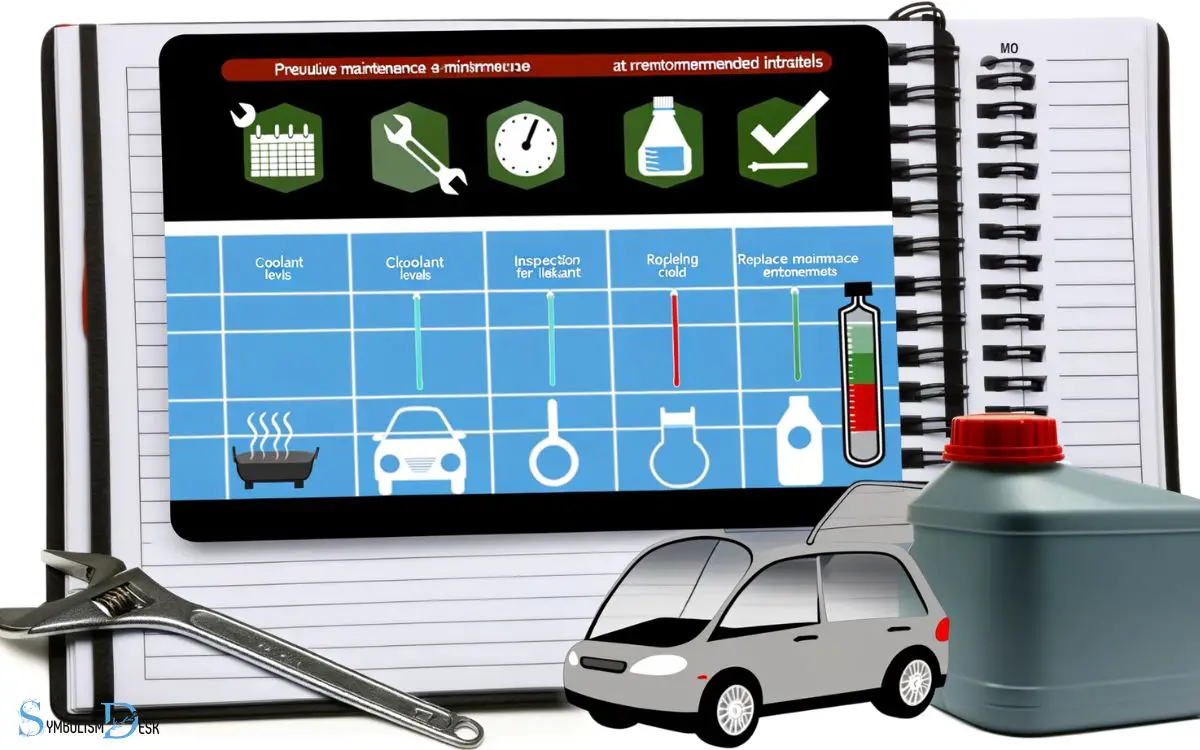
To ensure the coolant levels are adequate, consider the following preventive maintenance measures:
- Check the coolant level regularly, especially before long drives or during extreme weather conditions.
- Inspect for any leaks in the cooling system that could result in a loss of coolant.
- Use the recommended coolant type and mix it with distilled water as per the manufacturer’s guidelines.
- Flush and replace the coolant at the intervals specified in the vehicle’s maintenance schedule.
- Keep the radiator and reservoir clean to prevent contaminants from affecting the coolant’s effectiveness.
Following these preventive maintenance steps will help to maintain the coolant levels and ensure the proper functioning of your vehicle’s cooling system.
Safe Driving Practices to Avoid Overheating
Safe driving practices play a crucial role in preventing overheating issues in your vehicle. Proper driving habits can help maintain optimal engine temperature and prevent coolant system failures.
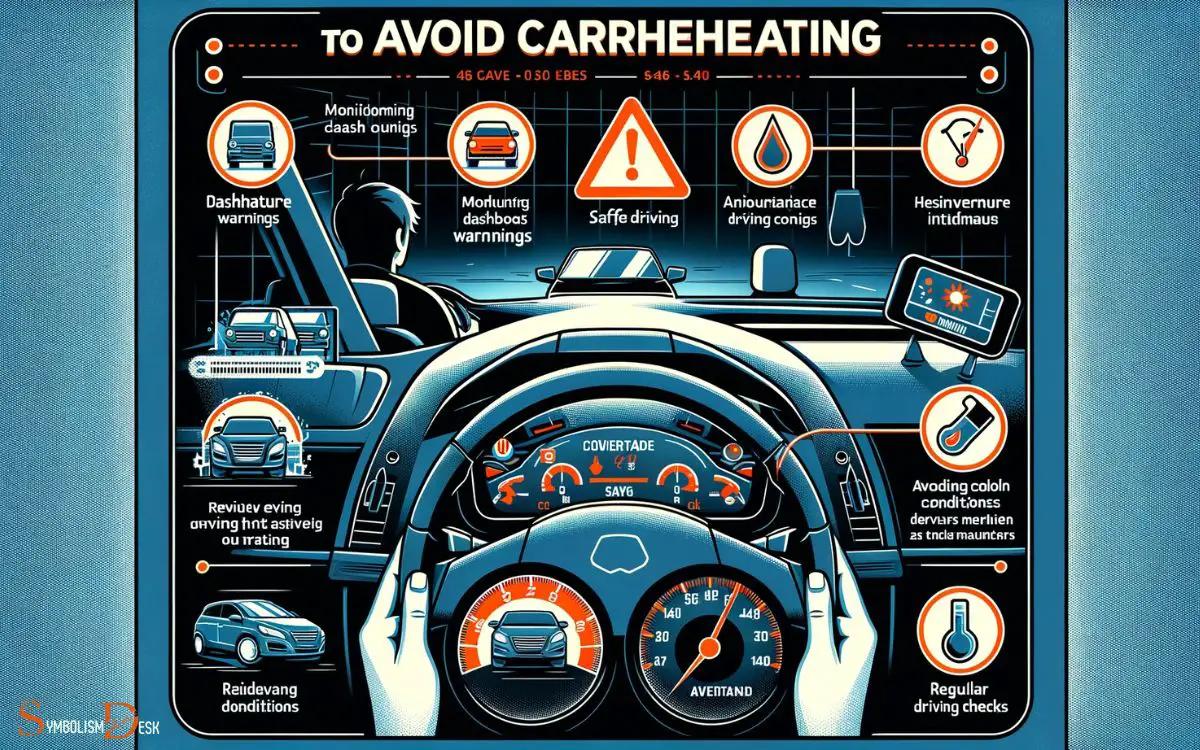
Here are some essential safe driving practices to avoid overheating:
| Safe Driving Practices | Description |
|---|---|
| Avoid Heavy Traffic | Heavy traffic can lead to prolonged idling, causing the engine to overheat. Try to use less congested routes or plan your travel during off-peak hours. |
| Monitor Coolant Levels | Regularly check the coolant levels and ensure they are within the recommended range. Low coolant levels can lead to overheating. |
| Use Air Conditioning Wisely | Running the air conditioning puts extra load on the engine. Use it judiciously, especially during hot weather and uphill drives. |
| Maintain Consistent Speed | Sudden acceleration and braking can strain the engine, leading to overheating. Maintain a consistent speed to reduce engine stress. |
Conclusion
Understanding the low water symbol in a car, addressing the warning, and checking coolant levels are essential for preventing potential risks and maintaining a safe driving environment.
Topping up coolant and seeking professional assistance when needed, along with practicing preventive maintenance, are important steps to ensure the proper functioning of the coolant system.
By following these safe driving practices, drivers can avoid the dangers of overheating and ensure a smooth driving experience.



